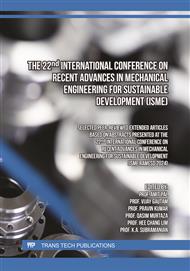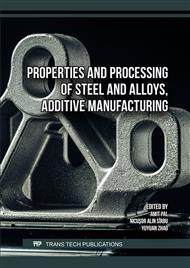[1]
D.D. Gu, W. Meiners, K. Wissenbach, R. Poprawe, Laser additive manufacturing of metallic components: materials, processes and mechanisms, Int. Mater. Rev. 57 (2013) 133–164.
DOI: 10.1179/1743280411Y.0000000014
Google Scholar
[2]
D.-G. Ahn, Directed energy deposition (DED) process: state of the art, Int. J. Precis. Eng. Manuf. Technol. 8 (2021) 703–742.
DOI: 10.1007/s40684-020-00302-7
Google Scholar
[3]
Y. Koli, J.G. Roy, N. Yuvaraj, Vipin, G. Vedabouriswaran, Microstructural evolution, ferrite content, and grain size study in the coalescence of high nitrogen austenitic stainless steel thick plates using cold metal transfer welding process, J. Mater. Eng. Perform. (2023).
DOI: 10.1007/s11665-023-08247-z
Google Scholar
[4]
Y. Koli, S. Aravindan, P.V. Rao, Influence of heat input on the evolution of δ-ferrite grain morphology of SS308L fabricated using WAAM-CMT, Mater. Charact. 194 (2022) 112363.
DOI: 10.1016/j.matchar.2022.112363
Google Scholar
[5]
S.M. Adinarayanappa, S. Simhambhatla, Twin-wire welding based additive manufacturing (TWAM): Manufacture of functionally gradient objects, Rapid Prototyp. J. 23 (2017) 858–868.
DOI: 10.1108/RPJ-09-2015-0126
Google Scholar
[6]
Q. Fang, L. Zhao, C. Chen, Y. Zhu, Y. Peng, F. Yin, Effect of heat input on microstructural and mechanical properties of high strength low alloy steel block parts fabricated by wire arc additive manufacturing, Mater. Today Commun. 34 (2023).
DOI: 10.1016/j.mtcomm.2022.105146
Google Scholar
[7]
K. Dağyıkan, U. Gürol, M. Koçak, Characterization and fracture toughness evaluation of the thick-walled wire arc additively manufactured low alloy steels, Weld. World 67 (2023) 1009–1019.
DOI: 10.1007/s40194-022-01424-z
Google Scholar
[8]
V.R. Duarte, T.A. Rodrigues, N. Schell, T.G. Santos, J.P. Oliveira, R.M. Miranda, Wire and Arc Additive Manufacturing of High-Strength Low-Alloy Steel: Microstructure and Mechanical Properties, Adv. Eng. Mater. 23 (2021).
DOI: 10.1002/adem.202001036
Google Scholar
[9]
B. Wittig, M. Zinke, S. Jüttner, Influence of arc energy and filler metal composition on the microstructure in wire arc additive manufacturing of duplex stainless steels, Weld. World 65 (2021) 47–56.
DOI: 10.1007/s40194-020-00995-z
Google Scholar
[10]
V.T. LE, A preliminary study on gas metal arc welding-based additive manufacturing of metal parts, Sci. Technol. Dev. J. 23 (2020).
DOI: 10.32508/stdj.v23i1.1714
Google Scholar
[11]
Y. Koli, S. Aravindan, P. V. Rao, Wear characteristics of wire-arc additive manufactured SS308L, J. Tribol. 145 (2023).
DOI: 10.1115/1.4056191
Google Scholar
[12]
B.P. Nagasai, S. Malarvizhi, V. Balasubramanian, Effect of welding processes on mechanical and metallurgical characteristics of carbon steel cylindrical components made by wire arc additive manufacturing (WAAM) technique, CIRP J. Manuf. Sci. Technol. 36 (2022) 100–116.
DOI: 10.1016/j.cirpj.2021.11.005
Google Scholar
[13]
D.M. Vaughan, A. Nycz, M.W. Noakes, C. Masuo, SS410 process development and characterization, Solid Free. Fabr. 2019 Proc. 30th Annu. Int. Solid Free. Fabr. Symp. - An Addit. Manuf. Conf. SFF 2019 (2019) 404–414.
Google Scholar
[14]
S.S. Babu, The mechanism of acicular ferrite in weld deposits, Curr. Opin. Solid State Mater. Sci. 8 (2004) 267–278.
DOI: 10.1016/j.cossms.2004.10.001
Google Scholar
[15]
Y. Shi, Z. Han, Effect of weld thermal cycle on microstructure and fracture toughness of simulated heat-affected zone for a 800MPa grade high strength low alloy steel, J. Mater. Process. Technol. 207 (2008) 30–39.
DOI: 10.1016/j.jmatprotec.2007.12.049
Google Scholar
[16]
B. Wang, J. Lian, Effect of microstructure on low-temperature toughness of a low carbon Nb–V–Ti microalloyed pipeline steel, Mater. Sci. Eng. A 592 (2014) 50–56.
DOI: 10.1016/j.msea.2013.10.089
Google Scholar
[17]
D.C. Ramachandran, J. Moon, C.-H. Lee, S.-D. Kim, J.-H. Chung, E. Biro, Y.-D. Park, Role of bainitic microstructures with M-A constituent on the toughness of an HSLA steel for seismic resistant structural applications, Mater. Sci. Eng. A 801 (2021) 140390.
DOI: 10.1016/j.msea.2020.140390
Google Scholar



